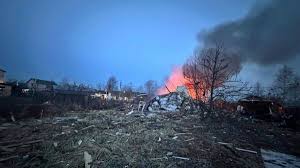Largest Drone Attack of War Hits Moscow Region, Leaving Three Dead and Several Injured
Table of Contents
ToggleIn what is being described as the largest drone attack on Moscow since the war began, at least three people have been killed and 18 injured, including three children, according to Russian officials. The drone assault, reportedly orchestrated by Ukraine, targeted the Moscow region and marks a significant escalation in the conflict.
Casualties and Damage
Regional Governor Andrei Vorobyev stated that the casualties occurred in the towns of Vidnoye and Domodedovo, situated just outside the Russian capital. Among the fatalities was a 50-year-old man who succumbed to his injuries at a hospital. Two other victims, reportedly workers at a food company, lost their lives while beginning their shifts. The company’s distribution center suffered significant damage when debris from the drones struck the premises, damaging over 40 cars parked nearby.
A fourth fatality was later confirmed by Domodedovo official Evgeniya Khrustaleva. Additionally, two people remain in critical condition at a local hospital. One is a 43-year-old woman suffering from severe torso injuries, including intestinal damage, while the other is a 44-year-old man with wounds to his torso, shoulder, and shin.
Extent of the Drone Assault
According to Russia’s state news agency Tass, 91 out of 337 drones were shot down over the Moscow region. The Russian Defense Ministry later confirmed that the attack extended beyond Moscow, with drones intercepted or destroyed in nine other Russian regions, including Kursk. Governor Vorobyev also shared images on social media showing damaged apartments and charred vehicles in a parking area.
Moscow Mayor Sergei Sobyanin said seven apartments in a residential building were impacted, with the roof of one building damaged by wreckage. Although he described the damage as “insignificant,” 12 residents, including three children, had to be evacuated from the affected apartments.
Impact on Transportation
Following the drone strikes, flight restrictions were imposed on Moscow’s four major airports: Sheremetyevo, Domodedovo, Vnukovo, and Zhukovsky. Additionally, airports in the Yaroslavl and Nizhny Novgorod regions were affected, as they are key transport hubs used by millions of passengers annually. While flights resumed at Sheremetyevo Airport, the temporary disruption had a ripple effect on flight schedules and passenger itineraries.
One district train network also faced suspension, adding to the region’s transport chaos. As Moscow struggled to restore normalcy, the drone attack underscored the ongoing vulnerability of Russia’s capital to aerial assaults.
Ukraine’s Response
Interestingly, Ukrainian authorities have not publicly acknowledged responsibility for the drone attack. However, this is not the first time Ukraine has been accused of targeting Moscow and its surrounding regions. Kyiv has previously remained silent on similar incidents, maintaining strategic ambiguity while focusing on defending its own cities from Russian bombardments.
Overnight, Ukraine itself faced drone attacks from Russia, with strikes reported in the capital Kyiv and several other regions. Ukraine’s air force claimed to have intercepted 79 of the 126 drones launched by Russia, along with an Iskander-M ballistic missile. Electronic warfare countermeasures reportedly prevented 35 additional drones from reaching their intended targets.
Geopolitical Implications
The timing of the attack is noteworthy, as it occurred just hours before a high-stakes meeting between U.S. and Ukrainian officials in Saudi Arabia aimed at negotiating a path to peace. U.S. Secretary of State Marco Rubio, who is attending the meeting, suggested that Ukraine might have to make territorial concessions to Russia as part of a ceasefire agreement. This statement has already stirred controversy, as Ukraine has consistently vowed to reclaim its occupied territories.
The Jeddah meeting marks the first official dialogue since last month’s heated exchange between Ukrainian President Volodymyr Zelensky and former U.S. President Donald Trump at the White House. Rubio’s comments hint at mounting international pressure to find a diplomatic resolution, even if it means making difficult compromises.
Context of Escalation
This drone attack marks a new chapter in the ongoing conflict, signaling Ukraine’s ability to strike at the heart of Russia’s capital. In recent months, Moscow has witnessed a surge in drone activity, prompting heightened security measures and increased air defense deployments. While many drones are intercepted before causing damage, the psychological impact on Moscow’s residents is palpable.
The attack also raises questions about the effectiveness of Russia’s air defense systems, as a considerable number of drones still managed to hit various targets despite the military’s interception efforts. The growing use of drone warfare highlights a shift in combat tactics, where low-cost, high-impact strikes are reshaping the battlefield.
Strategic Significance
Military analysts believe that the drone assault may be aimed at undermining Russia’s sense of invulnerability and exposing vulnerabilities within its defense systems. While the direct damage may seem limited, the symbolic impact of drones reaching the capital is substantial. It serves as a stark reminder that the conflict is not confined to the frontlines and can spill over into Russian territory.
The attack also underscores Ukraine’s willingness to leverage unconventional warfare to keep Russian forces on the defensive. With Moscow now included in the conflict’s reach, public perception within Russia could shift, potentially influencing domestic support for the war.
Looking Ahead
As the international community watches closely, the attack could shape diplomatic efforts aimed at de-escalation. The U.S. and its allies are likely to evaluate the incident’s impact on the peace talks in Jeddah, especially amid Rubio’s controversial remarks suggesting territorial compromise.
In the longer term, the use of drones is poised to remain a crucial aspect of modern warfare, forcing nations to invest more in advanced air defense systems and electronic countermeasures. For Moscow, the largest drone attack to date serves as a sobering indication that despite its vast military prowess, it remains vulnerable to asymmetric threats.
As the conflict drags on with no clear end in sight, both Russia and Ukraine continue to explore new tactics, keeping the world on edge and diplomatic solutions increasingly elusive.
Read News: Specialty Battery Market Size, Share, Trends Research Report 2025-2034

